High Ankle Sprain
High Ankle Sprain
If you have ever experienced ankle pain, you may be wondering if you sprained your ankle. Many people use the terms “sprain” and “strain” interchangeably, but they are actually two different injuries. A sprain is an injury to a ligament, while a strain is an injury to a muscle or tendon. In this article, we will talk about the high ankle sprain: what it is, how to diagnose it, and how to treat it. We will also cover ways to prevent a high ankle sprain from occurring.
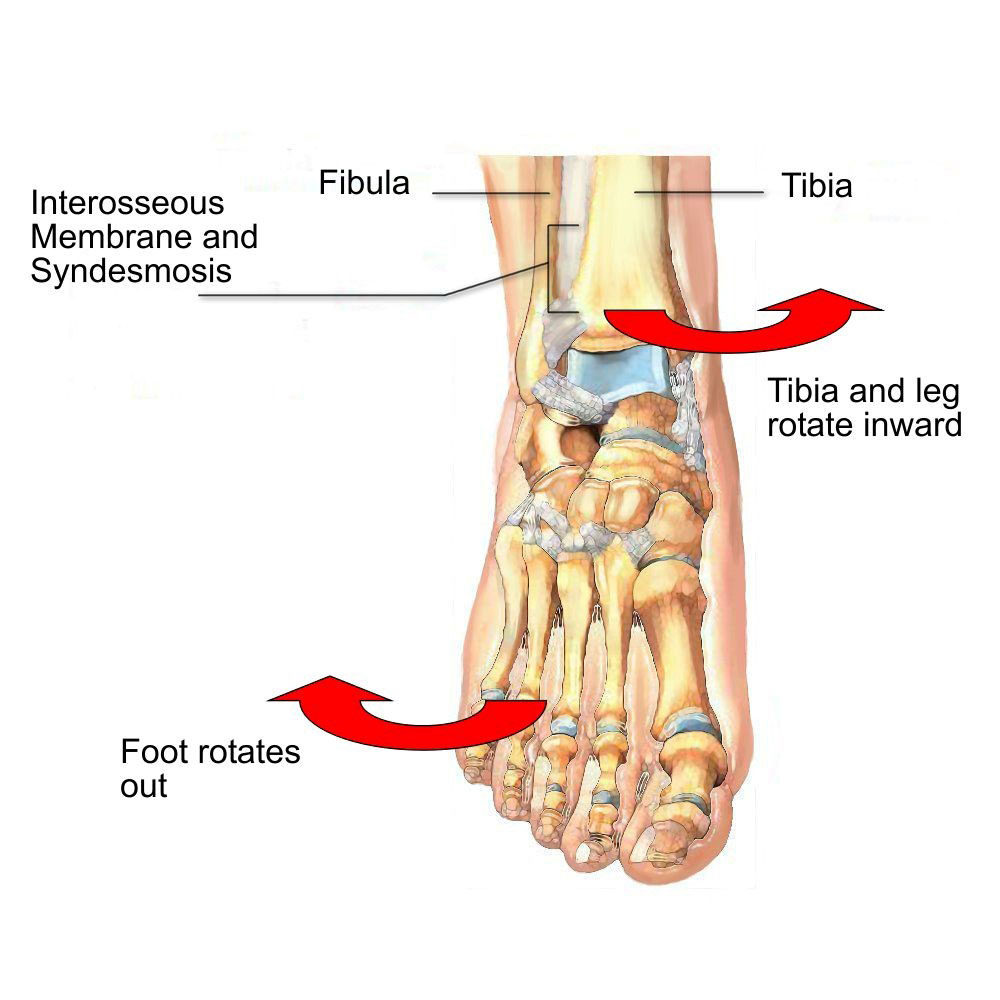
What exactly is a high ankle sprain?
A high ankle sprain is a type of injury that can occur when the ligaments that connect the lower leg bones to the upper leg bones are stretched or torn. This type of injury is often seen in athletes who participate in activities that involve sudden stops or changes in direction, such as basketball or football.
High ankle sprains can range from mild to severe, and depending on the extent of the injury, may require a period of rest and rehabilitation before returning to activity. Treatment for such a sprain typically includes ice, elevation, and immobilization. In more severe cases, surgery may be necessary to repair the damaged ankle ligaments.
Are high ankle sprains the same as low ankle sprains?
No, high ankle sprains are different from low ankle or medial ankle sprains. These sprains usually occur when the foot is rotated outward, while low ankle sprains typically happen when the foot is turned inward. The symptoms of a high ankle sprain may include pain and swelling above the affected joint, while those of a low ankle sprain is usually limited to the area below the joint.
Treatment for both types of sprains typically involves rest, ice, and elevation of the affected leg. However, more severe high ankle sprains may require immobilization or surgery. Low ankle sprains usually heal within a few weeks, but high ankle sprains can take several months to fully recover.
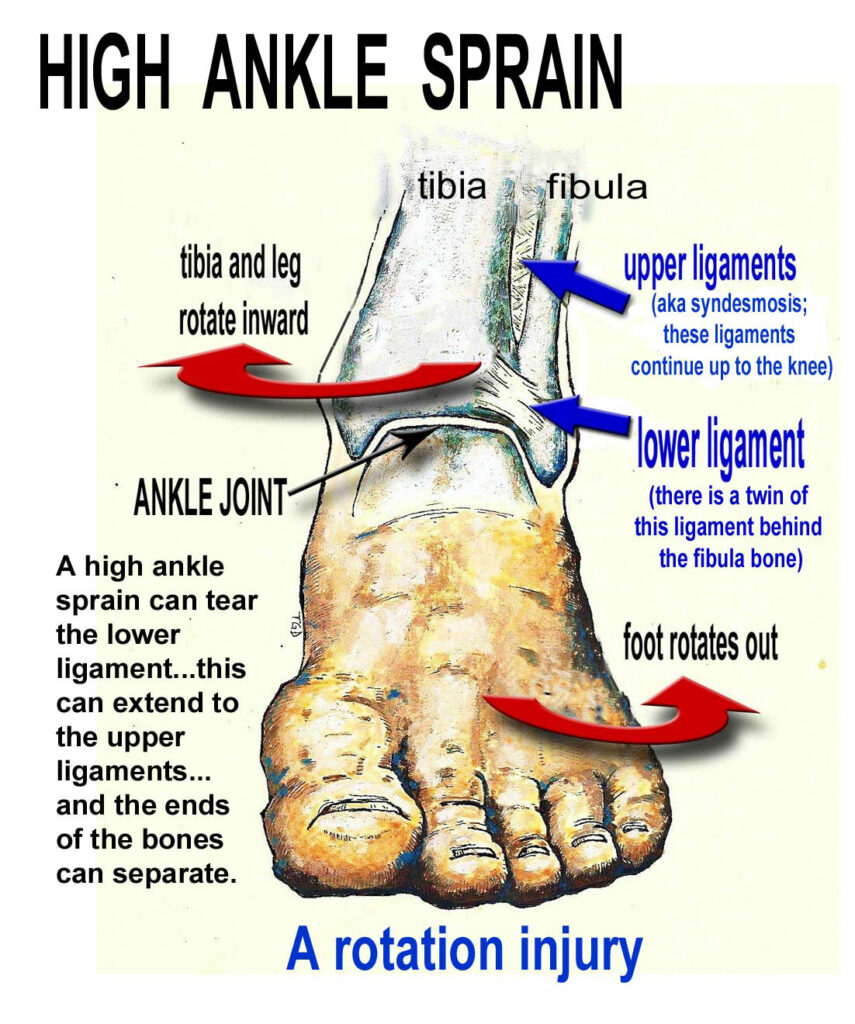
Why do high ankle sprains occur?
A sports hernia is often difficult to diagnose because it can mimic other types of injuries. Your doctor will likely ask about your symptoms and medical history. They will also perform a physical examination. This may include tests to check for weakness, tenderness, and range of motion in the affected area.
Imaging tests, such as an MRI or ultrasound, may also be used to diagnose a sports hernia.
How is a sports hernia treated?
These sprains occur when the ligaments that connect the bones of the lower leg to the bones of the foot are stretched or torn. This can happen when the foot is turned inward (inversion) or outward (eversion). Tibia and fibula, the ligaments spanning the lower leg bones, may also get damaged in some cases.
Such sprains are more common in athletes who participate in sports that involve jumping or quick changes in direction, such as basketball, soccer, and volleyball.
Most high ankle sprains occur when the foot lands awkwardly after a jump or a fall, or when there is a sudden change in direction. The ligaments may be stretched beyond their normal range of motion, which can cause them to tear. In some cases, the ligament may be completely torn away from the bone.
While anyone can experience such a sprain, these sprains are most common in athletes who participate in sports that involve jumping or quick changes in direction, such as basketball, soccer, and volleyball.
These high ankle sprains typically occur when the foot lands awkwardly after a jump or a fall, or when there is a sudden change in direction. The ligaments may be stretched beyond their normal range of motion, which can cause them to tear. In some cases, the ligament may be completely torn away from the bone.
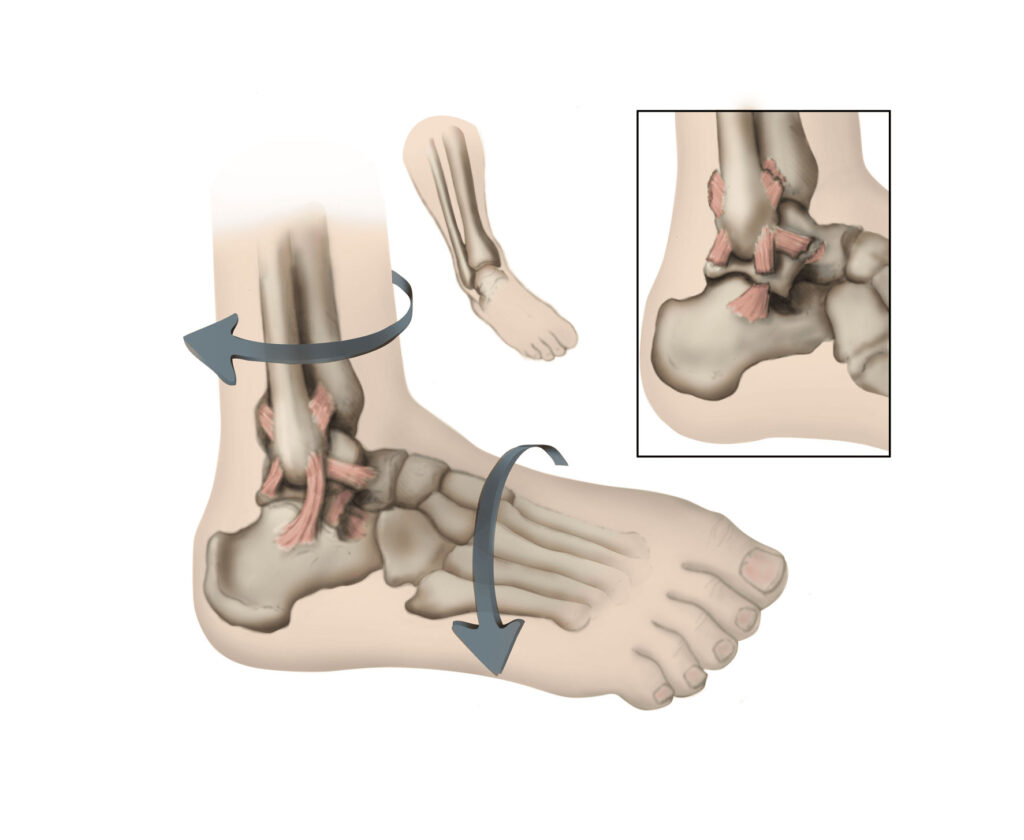
Which ligaments get torn in a high ankle sprain?
There are actually two ligaments that are commonly involved in a high ankle sprain: the anterior talofibular ligament (ATFL) and the posterior talofibular ligament (PTFL).
The ATFL is located on the outside front of the ankle, while the PTFL is located on the back outside portion of the ankle.
These ligaments work together to stabilize the joint and keep the foot from rolling over too far. When one or both of these ligaments is stretched or torn, it can cause pain and swell in the area.
In some cases, surgery may be necessary to repair the damage.
Diagnosing a high ankle sprain
There are several ways that a high ankle sprain can be diagnosed.
Physical Examination
The first is through a physical examination. Your doctor will ask you about your symptoms and examine your ankle for swelling, tenderness, and bruising. He or she may also order X-rays to rule out any fractures.
If you suspect that you have a high ankle sprain, it is important to see your doctor as soon as possible so that you can get the high ankle sprain diagnosed and treated.
MRI or CT scan
The second way to diagnose a high ankle sprain is through an MRI or CT scan. These imaging tests can help to show the extent of the injury and whether any ligaments or tendons have been torn.
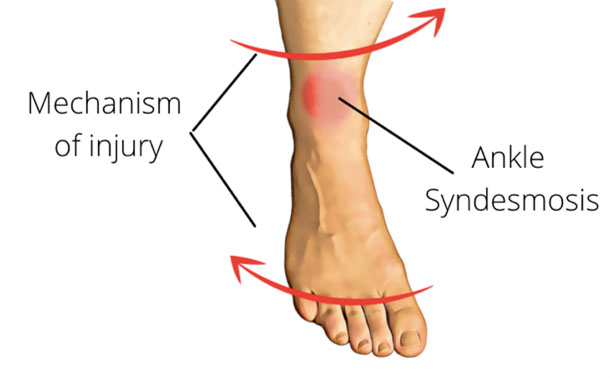
How do you treat a high ankle sprain?
If you have a high ankle sprain, it’s important to rest and ice the injury. You may also need to wrap the ankle or wear a boot to stabilize it. Your doctor may prescribe pain medication and physical therapy to help you recover. Surgery is rarely needed.
With proper treatment, most people recover from a high ankle sprain within a few weeks. Resting your ankle will help keep the swelling down and allow your ligaments time to heal.
Ice the injury for 20 minutes at a time, several times a day. You can also take over-the-counter pain relievers like ibuprofen to help with pain and inflammation.
Wrap the injured ankle with an ACE bandage or wear a stabilizing boot to keep the joint immobile and help prevent further injury. Your doctor may also prescribe crutches to keep weight off your ankle as it heals.
Physical Therapy
Physical therapy can help stretch and strengthen the ligaments around your ankle joint. This will help you recover your range of motion and prevent future injuries.
Surgery
In some cases, surgery may be necessary to repair the ligaments. However, this is rare and usually only done if the injury is severe or does not heal with nonsurgical treatment.
Recovery time for a high ankle sprain
Unlike a traditional ankle sprain, a high ankle sprain can take more time to heal when compared with lateral ankle sprains. It typically takes between four to eight weeks for a high ankle sprain to heal. However, some people may experience lingering pain and discomfort for several months.
A severe high ankle sprain may require surgery to correct the damage. Recovery times are also longer than a typical ankle sprain. Healing times vary depending on the individual, so it is important to consult with a doctor or other medical professional to get an accurate estimate.
Prevention tips for avoiding high ankle sprains
The most common way high ankle sprain occurs is by rolling it over. Wearing high-top shoes or boots can help stabilize your ankles and prevent them from rolling.
You should also avoid walking or running on uneven surfaces, and be careful when participating in activities that involve sudden starts and stops, such as basketball or tennis.
If you have a history of even typical ankle sprains, you may want to wear an ankle brace during activities that put you at risk for re-injury. Strengthening and stretching the muscles around your ankle can also help prevent an ankle injury
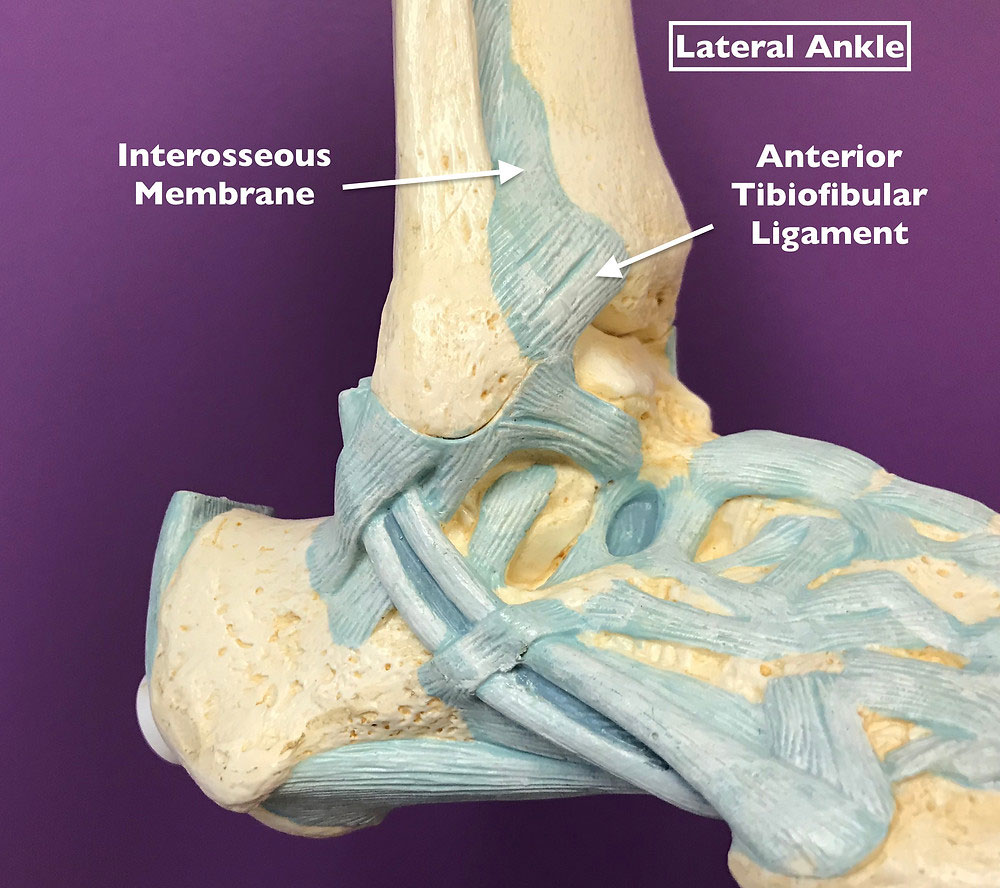
The prognosis for high ankle sprains
The prognosis for high ankle sprains is generally good. Most people will recover with conservative treatment, which may include rest, ice, and elevation. In some cases, however, surgery may be necessary to repair the ligaments.
The recovery time from a high ankle sprain can vary depending on the severity of the injury. For most people, however, the sprained ankle will heal within a few weeks to a few months.
If you have suffered a high ankle sprain, it is important to follow your doctor's instructions for treatment. This will help ensure that your ankle heals properly and helps reduce your risk of future injuries.
Contacting your healthcare provider for a high ankle sprain
If you have a high ankle sprain, you will most likely need to see your healthcare provider. This is because a high ankle sprain is a more serious injury than a regular ankle sprain.
A high ankle sprain can take longer to heal and may require special treatment. If you have any concerns about your injury, or if it does not seem to be healing properly, contact your healthcare provider.
The Bottom Line
High ankle sprains are common injuries that can occur in a variety of sports. They are often difficult to diagnose and can take a significant amount of time to heal properly. There are several things you can do to help prevent high ankle sprains, however, including strengthening your ankles and wearing supportive shoes. If you do suffer a high ankle sprain, be sure to follow the treatment recommendations from your doctor so that you can make a full recovery.
Frequently Asked Questions
It is generally recommended that you avoid playing sports while you are recovering from such sprains. This is because the risk of re-injury is high. Once your ankle has healed and the swelling has gone down, you can slowly start to participate in activities again. Be sure to consult with your doctor before returning to any sports or activities.
This sprain is generally more painful and swollen than a regular ankle sprain. You may also hear a popping noise when the injury occurs. If you suspect that you have a high ankle sprain, it is important to see your healthcare provider. They will be able to diagnose the injury and recommend the best course of treatment.
Most people who suffer from a high ankle sprain will make a full recovery. However, in some cases, the ligaments may not heal properly. This can lead to chronic ankle instability, which can increase your risk of re-injury. If you have any concerns about the long-term effects of this sprain, be sure to discuss them with your healthcare provider.
There is no definitive answer to this question since the severity of each injury depends on the individual case. However, in general, such a sprain is considered to be more serious than a regular ankle sprain since it involves ligaments that are located higher up on the leg near the knee.
No, high ankle sprains are not common. They account for only 2-3% of all ankle sprains. However, they can be very serious injuries that take a long time to heal. High ankle sprains often occur in sports that involve a lot of cutting and turning, such as football, soccer, and basketball.
Have you been injured at some point in your journey?
Are you not achieving your highest level of function?
We’ve helped hundreds of people at all walks in life
get back to performing their best painfree!
3 Ways to Level Up Your Rehab and Injury Prevention With Us





